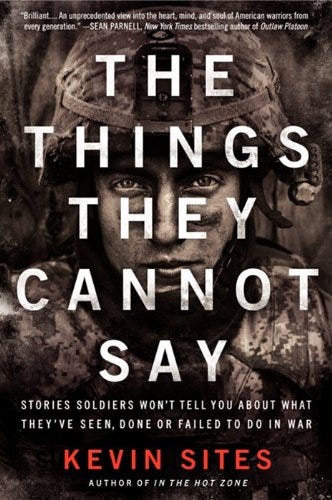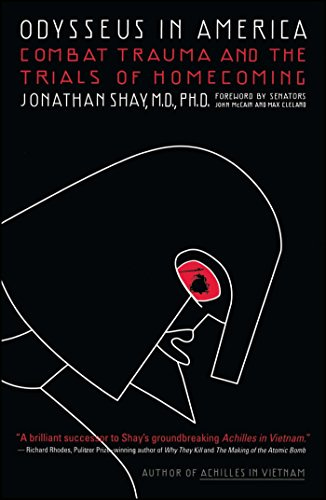Medieval PTSD
I’m currently reading The Things They Cannot Say, by Kevin Sites. It is a book about PTSD, primarily centered on wartime experiences in Iraq and Afghanistan. It is harrowing. PTSD is a well known condition in our culture, but the stories, told by the men themselves, of the cycle of killing, exhilaration, remorse, denial and acceptance, are…well, there are some emotions it is hard to find words for. It is not easy reading.

Sites was a war journalist who himself developed PTSD and an immense self-loathing as a result of his experiences and actions, or non-actions. The opening chapter lays bare his own pain—as he says, “how can you tell the truth about others if you cannot tell the truth about yourself?” (Side note: a difficult message for anyone who is writing a book as I am.)
There are live interviews between Kevin and one of the soldiers he wrote about, Lance Corporal William Wold. You can find them on Youtube, I’m not going to link to them. They are wartime footage; some of them are quite graphic, in terms of dead bodies; all of them are disturbing simply for the nature of the conversation. Corporal Wold struggled deeply on his return to “normal life” and would eventually die of a (likely accidental) drug overdose.
I’ve also been reading some of Philip Klay’s Redeployment, and Odysseus in America: Combat Trauma and the Trials of Homecoming, by Jonathan Shay, a psychiatrist to specializes in treating PTSD.

As I have been writing this series on Richard and his time, the central event, perhaps the main reason he and Saladin are so well known, is the Third Crusade. It was something akin to their World War, involving men from everywhere in Europe and the Middle East. As I have been working on my book, I’ve been thinking about how that experience impacted the lives of the ordinary men (and women!) who made up the bulk of the armies in the Crusade, whether Christian or Muslim. They were caught up in the events of their day, encouraged by religion and their communities to go and fight. Certainly, some were driven by the desire for plunder or riches; many more by the promise of forgiveness of sin, and the promise of salvation, by their respective religions. And the knightly class, who had been raised for war since their birth, likely felt like this is what they were born to do.
But the ordinary foot soldier, a butcher from France or a shop keeper from Damascus, was not raised for this. Sure, in that era people were more used to the sight of blood, whereas most of us have never seen an animal slaughtered, much less done it. Still, to wind up in midst of the chaos of battle, heads cut off, your friends burned alive in boiling oil, seeing people hold in their guts after a sword blow, resorting to cannibalism to survive a siege, or executing a prisoner by beheading him at your King’s command, as Richard required at the Siege of Acre—how could a knight, much less a normal “civilian” person, not be affected by that? And what impact might that have had as they returned to their homes?
There is some evidence for PTSD in the medieval, and ancient world, although of course they did not have that word for it. Dr. Shay wrote two books, Achilles in Vietnam and Odysseus in America, that use the Homeric legends to explore combat trauma.
“Plutarch’s Life of Marius speaks of Caius Marius’ behaviour who, when he found himself under severe stress towards the end of his life, suffering from night terrors, harassing dreams, excessive drinking and flashbacks to previous battles.”1
And what of the Middle Ages, the era we have been talking about? Let us turn to the Itinerarium Regis Ricardi, the Itinerary of Richard I and others in the Holy Land, by Richard de Templo (you can find our edition on Amazon here).
“Others, moreover, who endured in safety to the end, through the loss of their fathers, brothers, relations, and friends, who had perished of disease or by the sword, are believed to have endured a severe species of martyrdom, and diverse passions pierced their breasts as with a sword. Each, in his own way, we must admit it, endured a kind of martyrdom; every one, in short, of those, who with simple and devout hearts had exposed themselves for the love of God to this distant pilgrimage.”
Geoffroi de Charney, a medieval French knight of the 14th century, wrote The Book of Chivalry, a guide for knights of the era. In it, he says, for example:
“when they would be secure from danger, they will be beset by great terrors…”2
Especially given the tendency of medieval writers to describe combat in religious terms (“for God”) and not to engage in extended psychological explorations, we can see that combat trauma was real for those in the Middle Ages as well.
Penance is good for the soul, as they say. After the Norman conquest of England in 1066, led by William the Conqueror, penance was instituted as a way of dealing with the revulsion many felt for their actions:
Even by the competitive standards of the eleventh century, the king and his fellow warriors had been responsible for spilling an exceptionally large amount of blood. Indeed, it seems possible that some of the opposition the Conqueror faced during the campaign of 1069-70 [from his own troops] might have been due not merely to physical hardship but also to moral objections. … accounts of the Harrying [wholesale ravaging of the English countryside] suggest that, even in an age familiar with such atrocities, the scale of the human suffering was felt by some to be shocking.
William was acutely conscious of such criticism and the need to diffuse it. At an earlier stage in the Conquest, probably on the occasion of his victorious homecoming at Easter 1067, the bishops of Normandy had instituted a set of penances for those who had participated in the Hastings campaign; they survive in a fascinating document known today as the Penitential Ordinance. Since this was a highly unusual measure, and the Conqueror’s control over the Norman Church is well established, we can reasonably assume that he personally approved it, and regard it as a reflection of his ongoing desire to have his actions seen as legitimate.3
Obviously today’s PTSD treatment, including psychotherapy, medication, and even hallucinogens such as psilocybin, was not available to medieval combatants. But they may have an advantage modern-day warriors do not. Dr. Shay is firmly of the opinion that the rotation system (of the US Army in particular) is devastating to soldiers, because they do not go to war, and return home, with their community - they go, and return, alone, or with people they do not know. Medieval societies, especially during the Crusades, largely went to war as a community, in service to their local lord, and with their community, so that perhaps they had a better support structure, and support community, upon their return.
As someone who has been through some challenging startup experiences, it is not hard to see what we sometimes go through as a very pale imitation of what soldiers and front line medical professionals during COVID have gone through. Enough to give a lot of empathy to those who struggle with the real thing.
https://researchcentre.army.gov.au/library/land-power-forum/how-did-ancient-warriors-deal-post-traumatic-stress-disorder
https://theconversation.com/bodyguard-there-are-accounts-of-ptsd-in-warfare-from-homer-to-the-middle-ages-103306
https://fpif.org/warriors-suffered-ptsd-middle-ages/




